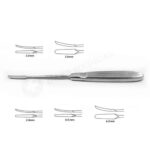In the intricate world of surgery, success often depends on the precision and quality of the instruments used. Surgeons rely on specialized tools designed for specific tasks, allowing them to perform complex procedures with accuracy and control. One such essential tool, often working behind the scenes, is the surgical raspatory. Though it may not be as widely known as a scalpel or forceps, its role in various surgical fields is indispensable for achieving optimal patient outcomes.

Understanding the Surgical Raspatory
So, what exactly is this instrument? A raspatory is a surgical tool designed primarily for scraping or filing bone or cartilage. Its name is derived from the word “rasp,” which means to scrape or abrade a surface with a rough instrument. These tools come in various shapes and sizes, each tailored for a specific anatomical area or surgical approach. They typically feature a textured, serrated, or sharp working end and a handle that provides a firm grip, allowing the surgeon to apply controlled force. The design ensures that tissue can be reshaped, smoothed, or removed without causing unnecessary damage to the surrounding structures.
Applications Across Surgical Specialties
The versatility of the raspatory makes it a staple in numerous surgical disciplines. In orthopedic surgery, it is frequently used to prepare bone surfaces for implants, remove bone spurs, or smooth rough edges after a fracture. During neurosurgery or spinal procedures, specialized raspatories help surgeons carefully scrape away bone to decompress nerves or access the spinal cord. Plastic and reconstructive surgeons also utilize delicate raspatories for fine bone sculpting, particularly in rhinoplasty (nose reshaping) and other facial contouring procedures. The ability to precisely modify bone and cartilage is crucial in both functional and aesthetic surgeries.
The Importance of Quality and Innovation
The effectiveness of a surgical procedure is directly linked to the quality of the instruments. A poorly crafted raspatory can be inefficient, requiring more force and potentially leading to less predictable results or damage to delicate tissues. This is where innovation and dedication to craftsmanship become critical. Companies like GreyMedical®, a privately owned medical technology company, are dedicated to innovation and excellence in the craft of surgical instruments. By focusing on superior materials, ergonomic design, and precise manufacturing, GreyMedical® ensures that surgeons have reliable and effective tools in their hands. This commitment to quality means that instruments like the raspatory perform exactly as intended, contributing to safer and more successful surgeries.
Conclusion
The raspatory is a perfect example of a specialized instrument that plays a vital role in modern surgery. Its function in scraping, filing, and shaping bone is fundamental to procedures across orthopedics, neurosurgery, and plastic surgery. The precision offered by high-quality raspatories allows surgeons to execute their plans with confidence, ultimately benefiting the patient. As surgical techniques continue to advance, the demand for expertly crafted instruments will only grow, highlighting the importance of companies committed to excellence in medical technology.

